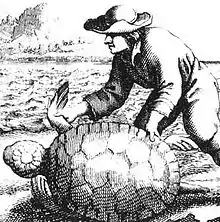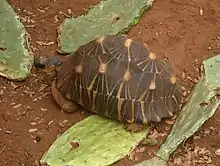Turtling (hunting)
Turtling is the hunting of turtles. Turtling has been a part of human culture since as far back as the middle of the first millennium BC, where sea turtles such as the hawksbill sea turtle (Eretmochelys imbricata) were eaten as delicacies in countries such as China.[1] While consumption and hunting of turtles is less common than it was in the past, this practice is still a part of communities throughout the globe, whether done legally or illegally.

.jpg.webp)


History
In Melanesian societies, it was common during funeral ceremonies, for locals to partake in a feast of turtle meat and other delicacies. The deceased were sealed into a tomb, and several years later it was tradition to reopen the tomb and to indulge once more on turtle meat. Because turtle meat was relatively rare, hunting the turtle for others during this time was considered to be a display of public generosity. While turtle hunting within this culture is not as common as it was decades ago, locals on Murray Island, Australia, continue to hunt green sea turtles (Chelonia mydas) during the turtle mating season. The turtles are pursued by groups of 3-6 hunters, where a leader, around one decade older than the other members of the group, uses a harpoon to kill the 100–150 kg turtle.[2]
Ecological research shows that turtle numbers decline with proximity to human settlements. This can be explained directly due to the hunting of turtles, or also indirectly with the ecology of fear principle, predation.[3]
Species at risk
While there are several turtle species at risk, the loggerhead sea turtle (Caretta caretta), which made the IUCU endangered animals list in 1996, and the leatherback sea turtle (Dermochelys coriacea) which has been experiencing a decline in numbers, are both still being hunted or killed due to human impact.[4] Another turtle species that can be hunted (not commercially) while considered as special concern at the Canadian and Ontarian level is the snapping turtle (Chelydra serpentin).[5] Hawksbill sea turtles have been hunted for their shells primarily to make jewelry.[6] Tourists will often buy items without being informed of the source of the material. Green sea turtles eggs are poached and eaten in many countries; this is also a tourist attraction and taking sea turtle shots, consuming raw turtle egg with whiskey or beer is popular in places like Costa Rica.[7]
Fishing bycatch
Capturing turtles as a byproduct of fishing has been recognized as a severe threat to turtle populations.[8] It has been acknowledged that fishing nets are the most devastating of fishing equipment to turtles, whether turtles are hunted intentionally or not.[9]
By region
Australia
In Australia it is estimated that 326 turtles from 6 different species, including the flatback sea turtle (Narator depressa) accounting for 59% of captures, and the hawksbill sea turtle accounting for 5%, were captured between 1989 and 1990.[8]
Africa
With a coast line of approximately 30,000 km, it is evident that Africa relies greatly on the fishing industry to feed the people and also as a trade product between other countries.[10] It is estimated that in Africa, an average of 180 turtles are caught per year using fishing hooks alone. Capture rate of turtles using a standard fishing hook is approximately 16 in 100,000. A sixteenth of the captured turtles are leatherback sea turtles, a species of turtle in which population numbers are declining. Conservation ecologists have estimated that should fishing efforts increase and fishing distribution remain the same, these numbers will increase to 770 turtles per year, threatening risked species of turtle.[11]
Madagascar

The radiated tortoise (Geochelone radiata) in Madagascar is in serious decline due to over-exploitation. The tortoise is protected under Malagasy law and is part of CITES, however enforcement is low and hunting persists.[12] Guards that are meant to protect the tortoise and prevent hunting are often paid off by the hunters.
Mexico
In Mexico sea turtles have been used for medicine, food and decoration since the 13th century. While hunting turtles is strictly forbidden in Mexico, approximately 35,000 turtles have been poached per year within the last decade around Baja California Sur. An estimated 65% of captured turtles are thought to be green sea turtles, while 10% consist of the endangered loggerhead sea turtle. The most common way poachers capture turtles is using a net designed specifically for turtles, which costs around $660. The majority of the poachers are local fisherman, who earn approximately US$78 per week. The turtles are sold locally, or reach the international black market where they fetch a profit of US$58 per turtle.[13]
The maximum punishment in Mexico for the poaching of turtles is nine years in jail and a fine of US$11,000. Poachers told researchers that the most efficient way of avoiding being caught is to either physically avoid patrols by driving away from them, or by paying a bribe.[13]
North American regulations on turtle hunting
Both the American and Canadian governments regulate the consumption, hunting and destruction of turtles and their eggs.[14]
In Canada the only specified type of turtle that is allowed to be hunted is the snapping turtle, which is considered to be a concern under the Endangered Species Act of the year of 2007. However, the hunting of turtles is strictly illegal in provincial parks of Canada. To hunt snapping turtles in Canada, individuals must own a valid sport license or a valid conservation fishing license. Turtles are not allowed to be hunted for commercial uses, and individuals transporting turtle carcasses must carry them in a box or by hand. Only two turtles are allowed to be hunted per day, and only four turtles can be on one person at any given time.[5]
Turtle hunting in New York State regulates two species of turtles, the diamondback terrapin and the snapping turtle. Snapping turtles are allowed to be hunted only between July 15 and September 30. A small game hunting license is required to hunt the turtle, and it is mandated that the turtle shell must be 12 inches long, or longer in a straight line. Turtles must be killed with a bow or firearm, and there is a limit of 30 turtles per year. Because of risk of food-borne contaminants, health advisories have been implemented with specific cooking instructions for public health.[15]
Similarly to regulation of snapping turtles, diamondback terrapin turtles are only allowed to be hunted during specific months of the year. The hunting season for diamondback terrapin turtles is from August 1 to April 30. In order to hunt diamondback terrapins, individuals must possess a hunting license specific to the species of turtle. Shells must be between 4 and 7 inches long, and must be released if the shell size is any different. Diamondback terrapin turtles must be captured by dip nets, seine nets, by hand or with a trap that must be checked on a daily basis.[15]
Regulating poaching
One of the most difficult obstacles to overcome with the hunting and poaching of sea turtles is the cultural aspect. Many countries, such as Costa Rica, have been hunting and eating sea turtles and sea turtle eggs for a very long time and consider it to be part of their culture. When scientists and conservationists try to explain to native poachers the detrimental impact their actions have on sea turtle populations, or when walking nightly patrols on the beach, they are met with hostility and sometimes violence.[16] Continuous education and outreach is important to mitigating the issue, in addition to beach patrols to prevent poachers from taking eggs or nesting female turtles. Implementing laws that protect animals, such as the radiated tortoise in Madagascar, can help population levels if proper enforcement is in place.[12]
References
- Schafer, Edward H. (1962). "Eating Turtles in Ancient China". Journal of the American Oriental Society. 82 (1): 73–74. doi:10.2307/595986. JSTOR 595986.
- Smith, E.A.; Bird, R.L.B. (2000). "Turtle hunting and tombstone opening: Public generosity as costly signaling". Evolution and Human Behavior. 21 (4): 245–261. doi:10.1016/S1090-5138(00)00031-3. PMID 10899477.
- Conwey-Gόmez, K (2007). "Effects of human settlements on abundance of Podocnemis unifilis and P. expansa turtles in Northeastern Bolivia". Chelonian Conservation and Biology. 6 (2): 199–255. doi:10.2744/1071-8443(2007)6[199:eohsoa]2.0.co;2.
- "IUCN Red List". Retrieved March 21, 2012.
- Government of Ontario. "Small Game Regulations" (PDF). Hunting Regulations. Retrieved March 21, 2012.
- Meylan, Anne (1999). "Status justification for listing the Hawksbill Turtle (Eretmochelys imbricata) as critically endangered on the 1996 IUCN red list of threatened animals". Chelonian Conservation and Biology. 3: 200–224.
- "Toasting with turtle eggs: It's legal in Ostional". The Tico Times Costa Rica. Retrieved 2018-11-15.
- Poiner, I.R.; Harris, A.N.M. (June 1996). "Incidental capture, direct mortality and delayed mortality of sea turtles in Australia's northern prawn fishery". Marine Biology. 125 (4): 813–825. doi:10.1007/BF00349264.
- Magnuson, J.J.; Magnuson, J.J.; Bjorndal, K.A.; Dupaul, W.D.; Graham, G.L.; Owens, D.W.; Peterson, P.C.H.; Pritchard, J.I.; Richardson, S.G.E (1990). "Decline of turtles: Causes and prevention". National Research Council.
- "Africa". Television Networks. LLC. Archived from the original on March 8, 2010. Retrieved March 21, 2012.
- Petersen, S.L.; Honig, M.B.; Ryan, P.G.; Nel, R.; Underhill, Lg.G. (April 2009). "Turtle bycatch in the pelagic longline fishery off southern Africa". African Journal of Marine Science. 31 (1): 87–96. doi:10.2989/AJMS.2009.31.1.8.779.
- O'Brien, Susan; Emahalala, Ellis R.; Beard, Vicki; Rakotondrainy, Riana M.; Reid, Ailsa; Raharisoa, Vola; Coulson, Tim (July 2003). "Decline of the Madagascar radiated tortoise Geochelone radiata due to overexploitation". Oryx. 37 (3): 338–343. doi:10.1017/S0030605303000590. ISSN 1365-3008.
- Mancini, A; Senko, J.; Borquez-Reyes, R.; Pόo, J.G.; Seminoff, J.A.; Koch, V. (2011). "To poach or not to poach an endangered species: Elucidating the economic and social drivers behind illegal sea turtle hunting in Baja California Sur, Mexico". Human Ecology. 39 (6): 743–756. CiteSeerX 10.1.1.458.7867. doi:10.1007/s10745-011-9425-8.
- FDA
- New York State Department of Environmental Conservation. "Small Game Hunting". New York State. Retrieved March 23, 2012.
- "Sea turtle conservationists attacked in Costa Rica". Mongabay Environmental News. 2015-07-16. Retrieved 2018-11-15.